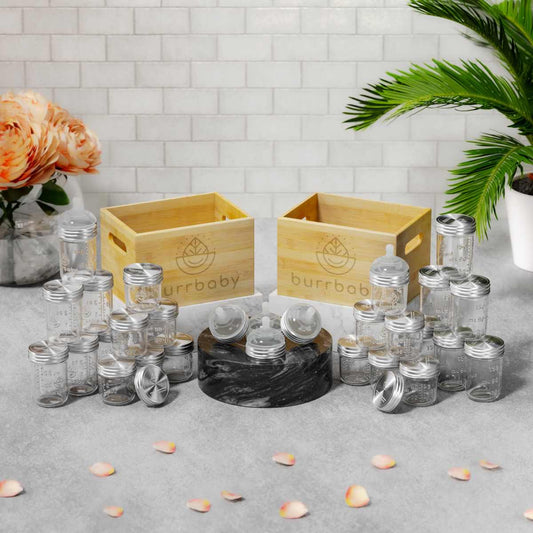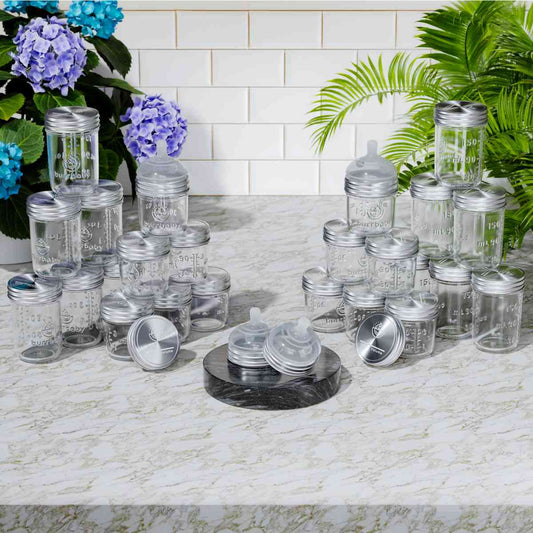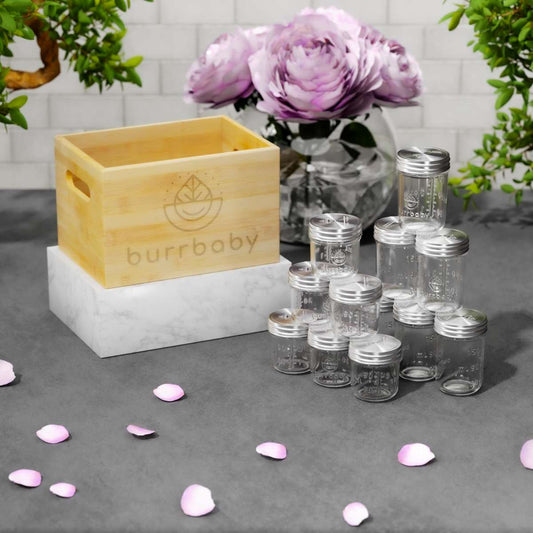As you walk down the toy aisle, it's amazing to see how many toys there are, most being made from cheap plastic. From colorful action figures to endless entertaining playsets, plastic has become the go-to material for toy companies and and parents, primarily due to its durability and affordability.
Unfortunately, the extensive use of plastic in creating toys, especially for babies, has also given rise to numerous health and environmental concerns.
As parents, ensuring the safety and well-being of our children is at the top of our priorities list, and for this reason, it's important to scrutinize the materials used in the toys we introduce to our little ones. In this article, we will dig into the potential harm caused by plastic toys on both health and the environment.
Article Overview
- The dangers of chemicals found in plastic toys.
- How babies are exposed to chemicals in plastic toys.
- Environmental impact of plastic toys.
- Alternatives to plastic toys for your baby.
At Burrbaby, we're dedicated to being a part of a healthier world for your children. We hope to accomplish this through our zero-plastic glass breast milk storage containers and bottles. These completely non-toxic, sustainable choices protect your baby's health and our planet.
The Dangers of Chemicals Found in Plastic Toys
Plastic toys may seem harmless, but if we've learned anything from the past, it's that they can contain hazardous chemicals that may harm children. As parents, we should be aware of the potential dangers associated with these chemicals, which can be found in both the plastic material and the paints or colors applied to the toys.
Bisphenols: BPA, BPS, and BPF
Bisphenols, such as BPA (Bisphenol A), BPS (Bisphenol S), and BPF (Bisphenol F), are industrial chemicals commonly found in plastic products, including toys. Research has shown that these chemicals can disrupt the endocrine system and are associated with various health issues, including developmental and reproductive problems and an increased risk of certain cancers.
In recent years, BPA-free products have become more popular; however, alternatives like BPS and BPF may still have similar adverse effects on health.

Phthalates
Phthalates are chemicals used as plasticizers, making plastics more flexible and durable.
They are often found in PVC (polyvinyl chloride) toys, including teething rings, bath toys, and dolls. Exposure to phthalates has been linked to reproductive issues, endocrine disruption, asthma, and developmental problems. In response to these concerns, the US government has banned certain phthalates from being used in children's toys and childcare products.
With that said, it always concerns us about which harmful chemicals are still in toys, and how they might adversely affect the health of our children.
Other harmful chemicals: PVC, lead, and cadmium
In addition to bisphenols and phthalates, other toxic chemicals can be found in plastic toys, such as lead and cadmium.
Lead and cadmium, both heavy metals, have been historically used in paints and pigments applied to toys. However, these metals can harm children if ingested or inhaled, causing developmental delays, neurological issues, and other health problems.
These should only be found in older toys, but again, companies throw whatever chemical works the best and is the cheapest into toys. It typically isn't until after evidence shows harmful side effects that they are banned, after the damage is done.
To keep your child safe, it's crucial to be aware of the potential dangers of chemicals in plastic toys, including the plastic material and the paints or colors used. By understanding the risks associated with plastic toys, parents can make informed decisions about the toys they provide for their children.
Head here to read more on how to create a healthy, eco-friendly nursery.
How Babies are Exposed to Chemicals from Plastic Toys
Mouthing and ingestion
Babies are naturally curious and often explore their surroundings using their mouths. This behavior, known as mouthing, is a normal part of early childhood development. However, when babies mouth plastic toys, they can unintentionally ingest the harmful chemicals they may contain. The chemicals can leach out from the toys and be absorbed by the child's delicate oral tissues, exposing them to potential health risks.
Skin contact
Skin contact is another pathway for chemical exposure from plastic toys. Babies have sensitive skin, and when they play with plastic toys for prolonged periods, harmful chemicals from the toys can be absorbed through their skin and enter their bodies. This is particularly concerning regarding toys with small parts or painted surfaces, with a higher risk of chemicals leaching out.
Babies are at a greater risk of exposure to harmful chemicals in plastic toys due to their natural exploratory behaviors, such as mouthing and skin contact. As parents and caregivers, it is essential we are aware of these risks and choose safer alternatives for your child's toys.
Environmental Impact of Plastic Toys

Plastic waste and pollution
Plastic toys are not only a potential health concern for children but also contribute significantly to global waste and pollution. It is estimated that 300 million tons of plastic waste are produced globally every year.
The problem with plastic toys is that they do not decompose quickly, taking hundreds of years or more to break down in landfills or the environment. As they disintegrate, they release harmful chemicals into the soil and water, posing threats to wildlife and ecosystems.
Limited recyclability
Recycling could be an effective solution to reduce plastic waste. However, plastic toys are difficult to recycle. Most plastic toys are not recyclable due to the variety of plastics used, mixed materials, and the presence of small parts or batteries. As a result, many plastic toys end up in landfills or the environment, where they take centuries to degrade and contribute to pollution.
By choosing eco-friendly alternatives, parents can contribute to the reduction of plastic waste and promote a healthier environment for future generations.
Alternatives to Plastic Toys for Your Baby
Wooden toys
Wooden toys are a fantastic alternative to plastic toys. They are made from natural materials and are biodegradable, which reduces their environmental impact. Wooden toys are also free of harmful chemicals like BPA, phthalates, PVC, lead, and cadmium, making them safer for babies.
In addition, wooden toys tend to be more durable and long-lasting, promoting a more extended play life and reducing waste. Finally, many experts argue that wooden toys can provide tactile, sensory, and cognitive benefits that help the child's overall development.
Cloth toys and stuffed animals
Cloth toys and stuffed animals made from organic, natural fibers like cotton, wool, or bamboo can also be safer for babies. These materials are gentler on the skin, free from harmful chemicals, and hypoallergenic. In addition, cloth toys and stuffed animals provide sensory and emotional benefits, such as comfort and companionship, for young children. Parents should look for toys made from certified organic materials and ensure that they meet safety standards.

Silicone toys
Silicone toys are another alternative to plastic toys. Silicone is a synthetic material derived from natural resources like sand and is considered safer than plastic.
Silicone toys are free from harmful chemicals and can resist temperature swings, making them suitable for use during teething. They are also easy to clean and sterilize, reducing the risk of bacterial growth. Parents should choose food-grade silicone toys that meet safety standards to ensure the highest quality for their babies.
Despite being much better than plastic, there is some research that shows compounds from silicone can be ingested by your baby, although it is not known if this is harmful. Also, it's important to note that while silicone is a big step up from plastic, it is still not nearly as environmentally friendly as wood since it takes a long time to degrade and is difficult to recycle.
Head here to read more about how to incorporate eco-friendly parenting practices.
Embracing a Healthier and Greener Future for Your Child
When you're choosing toys for your children, there's a lot to consider, and the material it's made out of should definitely be one. Young children are especially vulnerable as they often mouth toys and have prolonged skin contact. Plastic toys also contribute to global waste and pollution, with limited recyclability.
Parents can protect their children's health and promote a more sustainable lifestyle by choosing safer, eco-friendly alternatives such as wooden, cloth, and silicone toys.
Start with one or two and take it from there. Also, your kids probably don't need as many toys as you might think. :)
References
Consumer Product Safety Commission. Toy Safety Business Guidance and Small Entity Compliance Guide https://www.cpsc.gov/Business--Manufacturing/Business-Education/Toy-Safety-Business-Guidance-and-Small-Entity-Compliance-Guide
European Chemicals Agency. Toy Safety Directive https://echa.europa.eu/legislation-profile/-/legislationprofile/EU-TOY_SAFETY
Ginsburg, K. R., American Academy of Pediatrics Committee on Communications, & American Academy of Pediatrics Committee on Psychosocial Aspects of Child and Family Health. (2007). The importance of play in promoting healthy child development and maintaining strong parent-child bonds. Pediatrics, 119(1), 182-191. doi:10.1542/peds.2006-2697 https://publications.aap.org/pediatrics/article/119/1/182/70699/The-Importance-of-Play-in-Promoting-Healthy-Child
in the Design, Synthesis and Analysis of Chemical Engineering Processes (pp. 321-341). Elsevier. https://www.elsevier.com/books/sustainability-in-the-design-synthesis-and-analysis-of-chemical-engineering-processes/ruiz-mercado/978-0-12-802032-6
Koch, H. M., Rüther, M., Schütze, A., Conrad, A., Pälmke, C., Apel, P., & Brüning, T. (2017). Phthalate metabolites in 24-h urine samples of the German Environmental Specimen Bank (ESB) from 1988 to 2015 and a comparison with US NHANES data from 1999 to 2012. International Journal of Hygiene and Environmental Health, 220(2), 130-141 https://pubmed.ncbi.nlm.nih.gov/27863804/
Levesque, S., Robertson, M., & Klimas, C. (2022). A life cycle assessment of the environmental impact of children's toys. Sustainable Production and Consumption, 31, 777-793. doi: 10.1016/j.spc.2022.01.006 https://www.sciencedirect.com/science/article/abs/pii/S2352550922000550
Karas, K. & Frankowski, M. (2018). Analysis of hazardous elements in children toys: Multi-elemental determination by chromatography and spectrometry methods. Molecules, 23(11), 3017. doi: 10.3390/molecules23113017. https://www.ncbi.nlm.nih.gov/pmc/articles/PMC6278473/
Rochman, C. M., Browne, M. A., Halpern, B. S., Hentschel, B. T., Hoh, E., Karapanagioti, H. K., ... & Thompson, R. C. (2015). Classify plastic waste as hazardous. Nature, 494(7436), 169-171. https://www.nature.com/articles/494169a
United Nations Environment Programme. (2018). Single-use plastics: A roadmap for sustainability. https://www.unep.org/resources/report/single-use-plastics-roadmap-sustainability
Waste Management. How do I recycle my common household items? https://www.wm.com/us/en/support/faqs/how-do-i-recycle-my-common-household-items
Braun, J. M., Bellinger, D. C., Hauser, R., & Wright, R. J. (2017). Prenatal phthalate, triclosan, and bisphenol A exposures and child visual-spatial abilities. Neurotoxicology, 58, 75-83. https://pubmed.ncbi.nlm.nih.gov/27888119/
Cleveland Clinic. Teething Remedies for Your Baby's Aching Mouth. https://health.clevelandclinic.org/teething-remedies/
Rochester, J. R., & Bolden, A. L. (2015). Bisphenol S and F: A Systematic Review and Comparison of the Hormonal Activity of Bisphenol A Substitutes. Environmental Health Perspectives, 123(7), 643–650. https://pubmed.ncbi.nlm.nih.gov/25775505/
Braun, J. M., Sathyanarayana, S., & Hauser, R. (2013). Phthalate exposure and children's health. Current opinion in pediatrics, 25(2), 247-254. doi: 10.1097/MOP.0b013e32835e1eb6 https://www.ncbi.nlm.nih.gov/pmc/articles/PMC3747651
Schnur, J., & John, R. M. (2014). Childhood lead poisoning and the new Centers for Disease Control and Prevention guidelines for lead exposure. Journal of the American Association of Nurse Practitioners, 26(5), 238–247. https://pubmed.ncbi.nlm.nih.gov/24616453/
Vandenberg LN, Hauser R, Marcus M, Olea N, Welshons WV. Human exposure to bisphenol A (BPA). Reprod Toxicol. 2007 Aug-Sep;24(2):139-77. https://pubmed.ncbi.nlm.nih.gov/17825522/
North, E. J., & Halden, R. U. (2013). Plastics and Environmental Health: The Road Ahead. Rev Environ Health, 28(1), 1-8. doi: 10.1515/reveh-2012-0030. PMID: 23337043 https://www.ncbi.nlm.nih.gov/pmc/articles/PMC3791860/
Giuliani, A., Zuccarini, M., Cichelli, A., Khan, H., & Reale, M. (2020). Critical Review on the Presence of Phthalates in Food and Evidence of Their Biological Impact. International Journal of Environmental Research and Public Health, 17(16), 5655. doi: 10.3390/ijerph17165655 https://www.ncbi.nlm.nih.gov/pmc/articles/PMC7460375/
Eco-Healthy Childcare. University of California, Davis. https://health.ucdavis.edu/mindinstitute/resources/resources_pdf/Plastics_and_Plastic_Toys_7_14.pdf










